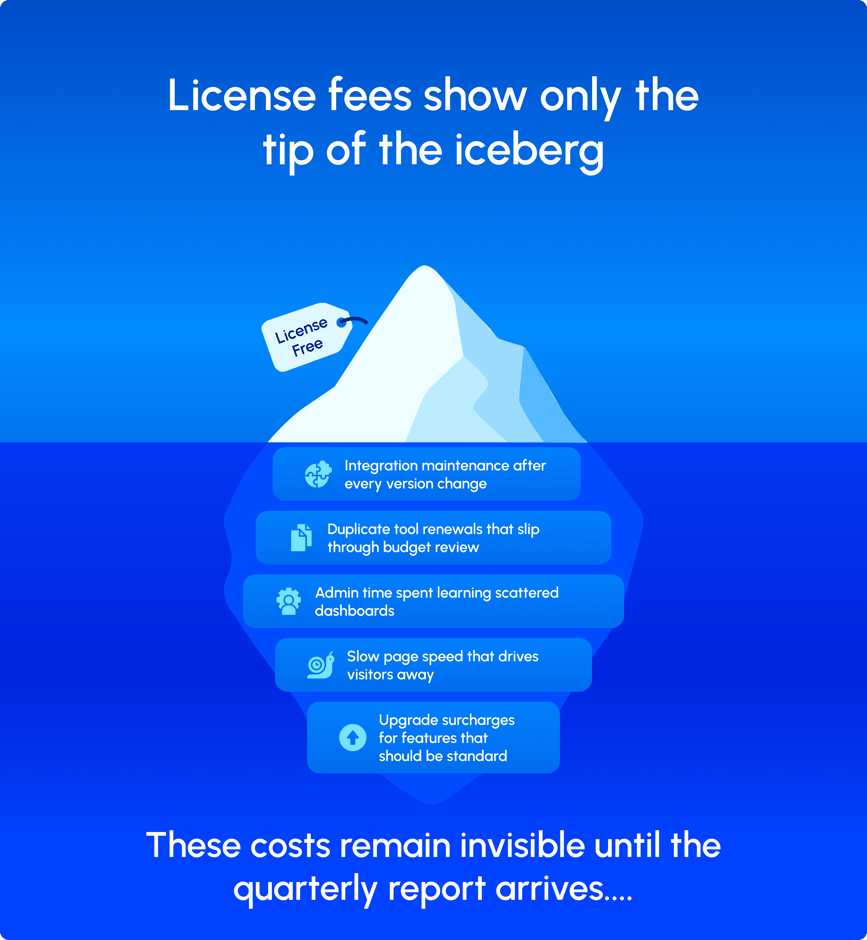Museums Are Spending More but Getting Less from Their Tech
Walk through any museum’s back office and you hear the same sighs. Ticketing screens still look like Windows 95. Donor data lives in a tool no one can customize without a consultant on retainer. Marketing works from spreadsheets because the “CRM” can’t store the fields they need. Point solutions arrive promising quick relief but soon become another silo.
Staff copy-and-paste visitor lists, then re-key gifts because two systems refuse to share a language. No one trusts the numbers, so meetings stall while departments reconcile reports. Hard costs rise with every new license. Soft costs pile up as talented people spend hours on manual fixes.
This patchwork was never a strategy; it grew one urgent purchase at a time.
Now IT budgets strain under maintenance fees and integration projects that never end. Programs slow, donors wait, and visitors notice the gaps.
Museums need a single, modern foundation that ends the sprawl and frees staff to focus on mission again.
The Tools That Piled Up Over Time
Each new system was the right answer to one problem: a donor database, a membership tool, a ticketing platform, an email solution. But none of them were built to work together. Over time, the museum tech stack grew like a city without a plan, with each department adding what it needed to get by.
The result?
Compounding costs and a growing share of staff time redirected away from mission work and toward maintenance, reconciliation, and training across systems.

The Costs You Don't See...Until You Do
The story is familiar: Tessitura for ticketing and memberships, Blackbaud for donor management, MailChimp or Constant Contact for email, and a mix of custom plug-ins to hold everything together. Each piece delivers value, but also brings overhead.
With every new tool comes not just a license fee, but a new integration, a new training burden, and a new layer of complexity. The visible costs are easy to justify. It’s the invisible ones - the ones hiding in staff time, duplicated effort, and brittle connections - that quietly drain budgets and momentum.
Month after month, those hidden expenses pull resources away from exhibitions, outreach, and education. They rarely show up in board packets, but they eat into mission delivery just the same.
There’s another path. HubSpot serves as the unified engine, with CRM, CMS, marketing automation, and reporting, trusted by more than 170,000 organizations. MuseumHub extends it with the cultural-sector tools museums need: timed ticketing, donor journeys, advancement workflows, and more.
Sure it's a software decision. But it's a financial decision, too. And when leaders ask why costs keep rising despite the best intentions, this is where the real story lives: below the waterline.

Speed without Tradeoffs
Some museum systems take a year or more to implement. During that time, costs rack up, staff morale dips, and momentum fades.
MuseumHub isn’t that.
Because it’s built on HubSpot, a stable, flexible platform with user-friendly onboarding, implementation moves quickly and confidently. Most teams start seeing results in weeks, not quarters. We work alongside your team to align with seasonal calendars and internal capacity. The goal isn’t just speed, our entire plan is built around giving your team early wins that build trust and deliver visible value.
One Platform, One Contract
Here’s what a typical museum workflow looks like today:
Marketing builds a list in MailChimp, exports it, uploads it into Tessitura, asks IT to sync back into Raiser's Edge, and waits for Finance to send ticket data from Excel.
That’s five platforms, three departments, and a morning lost.
With MuseumHub, it all lives in one place. A marketer builds an email, connects it to a ticketing module, and sends it to a donor segment, all in the same interface. Sales flow into real-time dashboards. IT supports one uptime system. Finance gets clean reporting without reconciliation.
Fewer tools. Fewer bottlenecks. More time for the work that moves your mission forward.
Behind the scenes, HubSpot's open API architecture connects with over 1,200 applications...and MuseumHub extends that power for the cultural sector. Whether it’s syncing with your collections database, integrating with your digital asset manager, or importing point-of-sale data, your stack stays flexible and future-ready.
New tools don’t mean starting over. They plug in, not pile on.

So What's Next?
Many institutions carry costs they can’t see and inefficiencies they’ve come to accept.
We help museum leaders uncover the full picture.
Through a focused Cost Briefing, we’ll analyze your current tools, integrations, and administrative workload - and compare them to a streamlined model built on HubSpot + MuseumHub.
The result is a clear cost comparison and a phased implementation plan tailored to your calendar and capacity.
See Your Tech Cost Breakdown
Get a custom model comparing your current stack to a streamlined solution

.webp?width=112&height=112&name=Karen%20Headshot%20(1).webp)

